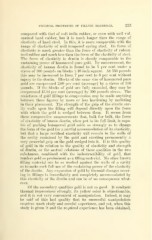Page 489 - My FlipBook
P. 489
PHYSICAL PROPEETIES OF FILLING MATERIALS. 225
compared with that of soft india rubber, or even with well vul-
canized hard rubber, but it is much longer than the range of
elasticity of hard steel. In this, it is more comparable with tbe
range of elasticity of well tempered spring steel. Its force of
elasticity is much greater than the force of elasticity of vulcan-
ized rubber and much less than the force of the elasticity of steel.
The force of elasticity in dentin is closely comparable to the
sustaining power of hammered pure gold. By measurement, the
elasticity of human dentin is found to be 5 per cent under a
stress of 300 pounds on blocks 1-10 inch square. At 350 pounds
this may be increased to from 7 per cent to 8 per cent without
injury to the dentin. Blocks of the same size of hammered pure
gold are compressed 2.09 per cent (average) by a stress of 300
pounds. If the blocks of gold are fully annealed, they may be
compressed 13.14 per cent (average) by 300 pounds stress. The
resistance of gold fillings to compression may be made anything
between these figures by more or less hardening by malleting
in their placement. The strength of the grip of the elastic cav-
ity walls upon the filling will depend directly upon the force
with which the gold is wedged between them. It seems from
these comparative measurements that, bulk for bulk, the force
of elasticity of human dentin, when put to its full limit, is capa-
ble of pushing hammered gold aside so strongly as to change
the form of the gold for a partial accommodation of its elasticity,
but that a large residual elasticity will remain in the walls of
the cavity sustained by the gold and exerting permanently a
very powerful grip on the gold wedged into it. It is this quality
of gold in its relation to the quality of elasticity and strength
of dentin, or the mutual relations of these qualities in the two
substances, combined with the indestructibility of gold, that
renders gold so preeminent as a filling material. No other known
filling material can be so worked against the walls of a cavity
as to make such full use of the sustaining power of the elasticity
of the dentin. Any expansion of gold by thermal changes occur-
ing in fillings is immediately and completely accommodated by
this elasticity of the dentin and can be of no consequence what-
ever.
Of the secondary qualities gold is not so good. It conducts
thermal impressions strongly, its yellow color is objectionable,
and it is not very convenient of manipulation. Indeed, it may
be said of this last quality that its successful manipulation
requires much study and careful experience, and yet, when this
study is given it and the required experience has been obtained,


